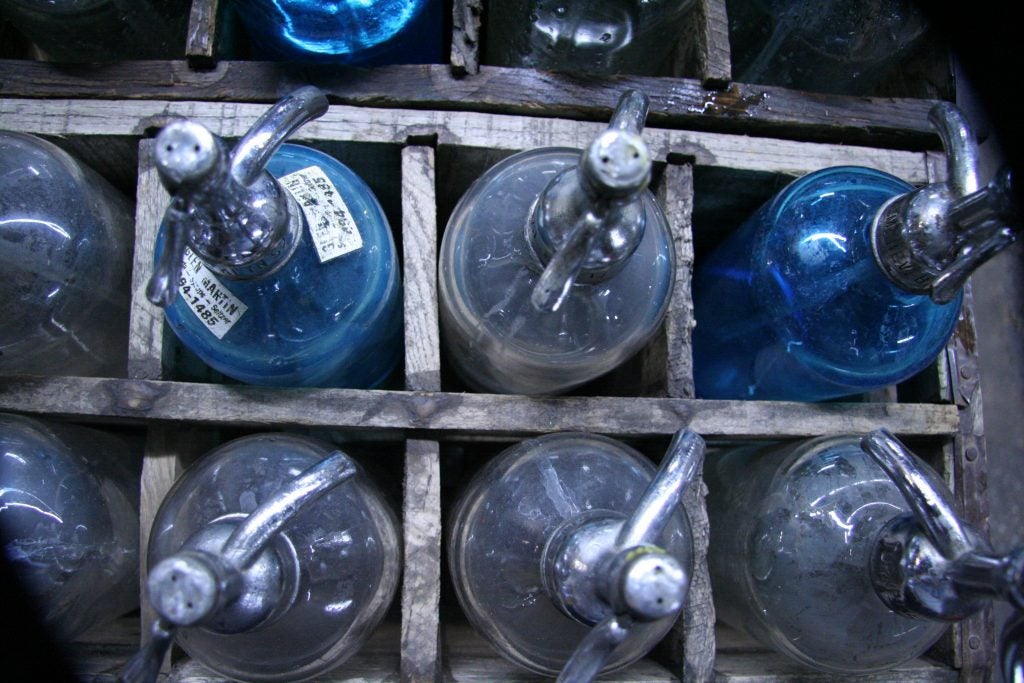Why we like sparkling water: The science behind the fizz
Bubbly water purveyors say “a good seltzer should hurt.” The acidity in carbonated drinks lights up the pain receptors in nerve endings — in a way that pleases the tongue.

People have enjoyed seltzer and other sparkling drinks for decades. Some of the bottles at the Brooklyn Seltzer Boys go back to the 1950s. (Alan Yu/WHYY)
The popularity of sparkling water has been bubbling up in the United States recently — Americans will buy more than 800 million gallons of it this year, according to one estimate.
But why do people like it?
Alex Gomberg’s family has been in the seltzer business since the 1950s. Seltzer men pick up the bottles in trucks and bring them to customers all around New York City, kind of like how milk men used to deliver milk.
Gomberg is now the vice president of the Brooklyn Seltzer Boys, and he says people like how the bubbles feel in their mouths.
The company stores and delivers seltzer in heavy glass bottles with a metal trigger that you press to squirt the seltzer out, and Gomberg says the bottles are made in such a way that the pressure inside remains the same, so it takes a long time before the drink in the bottle goes flat.

“When you drink it … you should be able to feel the bubbles in the back of your throat … so it should hurt at the back of your throat when you drink it, you shouldn’t be able to chug it,” Gomberg says.
The company slogan is “good seltzer should hurt.” And biologist Thomas Finger says that slogan captures the appeal of fizzy drinks.
“The perception we get from drinking a carbonated drink is actually quite complicated, we would call it conversationally taste, but really the word taste is itself hiding some complicated biology,” says Finger, a professor of psychology and brain sciences at the University of Colorado School of Medicine.
He says what we call the taste of seltzer is actually three things: taste, smell, but most importantly, touch: “if you pour soda water on your skin you can feel the kind of tickle from the bubbles there. It’s the same sensory system, but also the acidity of the carbonation is detected by the nerve endings, and we have the same kind of nerves innervating our eyeballs. So you can imagine if you spill seltzer water onto your eye, it wouldn’t feel very good, it would probably be painful.”
The sensation that we get from a fizzy drink comes from our pain receptors lighting up. A little pain can be nice, like eating spicy food, Finger says.
“In moderation most people like some degree of hot peppers or black pepper in their food, but as you increase the concentration, people begin to feel it as painful,” he said.
Notice that Finger says the taste of a fizzy drink comes from the acidity of the carbonation, and doesn’t mention bubbles. Bubbles certainly make a soda or beer look more refreshing, so much so that food photographers add dish soap to create bigger and longer lasting bubbles for ads, but in fact, the bubbles actually don’t matter that much.

Researchers at the Monell Chemical Senses Center found that it’s the acid in a fizzy drink that’s responsible for the bite. They tested this by having people drink carbonated water in a hyperbaric chamber, so the pressure killed the bubbles, but people still enjoyed the water the same.
For the companies that make fizzy drinks, that’s good information, they can turn down the bubbles in their formula, and still deliver the sting people love. Beer maker Anheuser-Busch paid for that research — because what’s true of fizzy water, is also true of fizzy beer.
WHYY is your source for fact-based, in-depth journalism and information. As a nonprofit organization, we rely on financial support from readers like you. Please give today.







